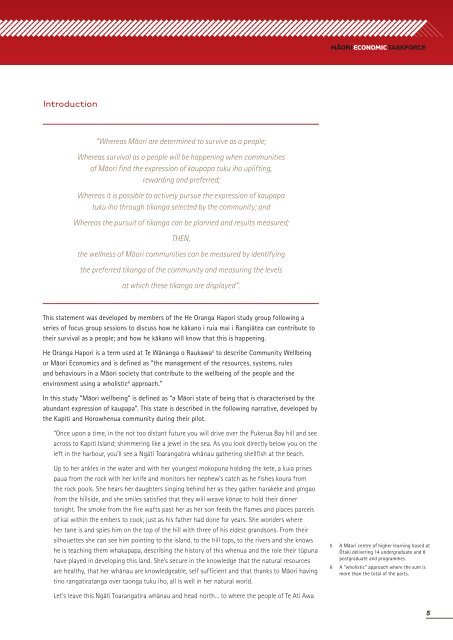He Oranga Hapori: A model for raising Maori ... - Te Puni Kokiri
He Oranga Hapori: A model for raising Maori ... - Te Puni Kokiri
He Oranga Hapori: A model for raising Maori ... - Te Puni Kokiri
- No tags were found...
You also want an ePaper? Increase the reach of your titles
YUMPU automatically turns print PDFs into web optimized ePapers that Google loves.
Introduction“Whereas Mäori are determined to survive as a people;Whereas survival as a people will be happening when communitiesof Mäori find the expression of kaupapa tuku iho uplifting,rewarding and preferred;Whereas it is possible to actively pursue the expression of kaupapatuku iho through tikanga selected by the community; andWhereas the pursuit of tikanga can be planned and results measured;THEN,the wellness of Mäori communities can be measured by identifyingthe preferred tikanga of the community and measuring the levelsat which these tikanga are displayed”.This statement was developed by members of the <strong>He</strong> <strong>Oranga</strong> <strong>Hapori</strong> study group following aseries of focus group sessions to discuss how he käkano i ruia mai i Rangiätea can contribute totheir survival as a people; and how he käkano will know that this is happening.<strong>He</strong> <strong>Oranga</strong> <strong>Hapori</strong> is a term used at <strong>Te</strong> Wänanga o Raukawa 5 to describe Community Wellbeingor Mäori Economics and is defined as “the management of the resources, systems, rulesand behaviours in a Mäori society that contribute to the wellbeing of the people and theenvironment using a wholistic 6 approach.”In this study “Mäori wellbeing” is defined as “a Mäori state of being that is characterised by theabundant expression of kaupapa”. This state is described in the following narrative, developed bythe Kapiti and Horowhenua community during their pilot.“Once upon a time, in the not too distant future you will drive over the Pukerua Bay hill and seeacross to Kapiti Island; shimmering like a jewel in the sea. As you look directly below you on theleft in the harbour, you’ll see a Ngäti Toarangatira whänau gathering shellfish at the beach.Up to her ankles in the water and with her youngest mokopuna holding the kete, a kuia prisespaua from the rock with her knife and monitors her nephew’s catch as he fishes koura fromthe rock pools. She hears her daughters singing behind her as they gather harakeke and pïngaofrom the hillside, and she smiles satisfied that they will weave könae to hold their dinnertonight. The smoke from the fire wafts past her as her son feeds the flames and places parcelsof kai within the embers to cook; just as his father had done <strong>for</strong> years. She wonders whereher tane is and spies him on the top of the hill with three of his eldest grandsons. From theirsilhouettes she can see him pointing to the island, to the hill tops, to the rivers and she knowshe is teaching them whakapapa, describing the history of this whenua and the role their tüpunahave played in developing this land. She’s secure in the knowledge that the natural resourcesare healthy, that her whänau are knowledgeable, self sufficient and that thanks to Mäori havingtino rangatiratanga over taonga tuku iho, all is well in her natural world.5 A Mäori centre of higher learning based atÖtaki delivering 14 undergraduate and 8postgraduate and programmes.6 A “wholistic” approach where the sum ismore than the total of the parts.Let’s leave this Ngäti Toarangatira whänau and head north... to where the people of <strong>Te</strong> Ati Awa5

















